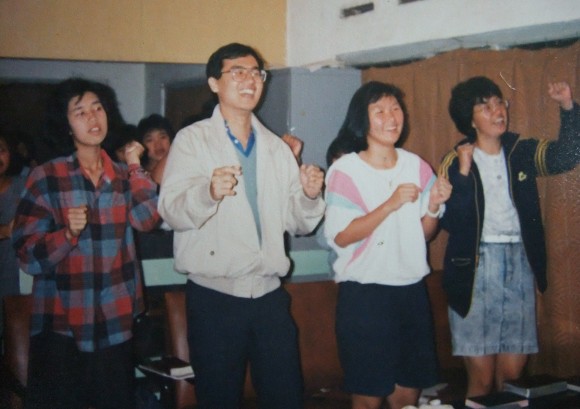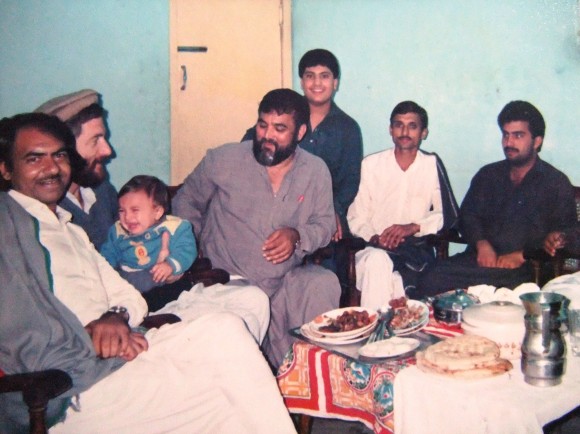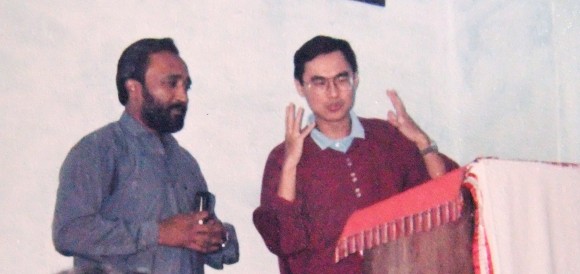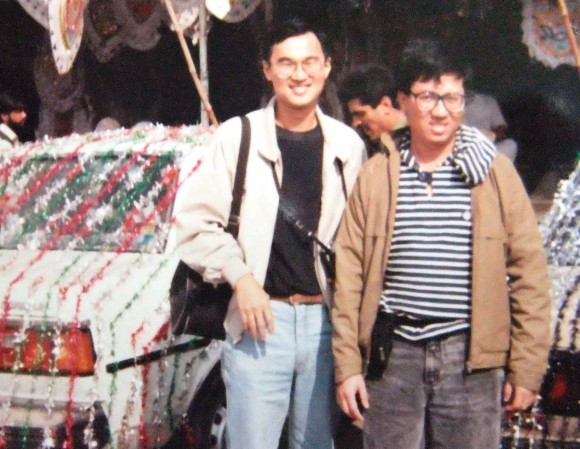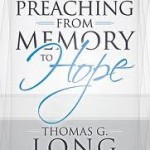 Every year I read at least one book on preaching to hone my craft and to deepen my convictions. This year I picked up from the Trinity library a book by Thomas G. Long titled Preaching from Memory to Hope, Louisville: Westminster John Knox Press, 2009. It was so helpful for me I excerpted passages for you to read and reflect on as well, especially those of you interested in preaching. Here’s what Thomas Long had to say in his book:
Every year I read at least one book on preaching to hone my craft and to deepen my convictions. This year I picked up from the Trinity library a book by Thomas G. Long titled Preaching from Memory to Hope, Louisville: Westminster John Knox Press, 2009. It was so helpful for me I excerpted passages for you to read and reflect on as well, especially those of you interested in preaching. Here’s what Thomas Long had to say in his book:
On tweaking narrative preaching for today’s listeners
“Some megachurch preachers have seemingly noticed, or perhaps intuited, an increased presence of episodic listeners and have, in response, begun fashioning “antinarrative” sermons (my term, not theirs), sermons that are built as a series of stand-alone “bullet points.” (We have perhaps returned in a digital age to the old “three-points-and-a-poem” style, except it’s now “eight bullet points and a video clip.” As one critic quipped, “when all you have are bullet-points, your ammunition is pretty quickly spent.) Hearers are invited to browse these sermons as they would a Web page, skipping here and there as interest would allow. Such preaching is immediately engaging to many people, but it tends to reinforce the fragmented, non-narrated character of contemporary life, and it works at a deep level, against the gospel. Narrative preachers, however, can learn something important from this approach. We may now be in a communicational moment when narrative preaching as it has often been practised is not viable. If we tell stories in sermons- biblical and otherwise- we will need also to step away from those stories and think them through in non-narrative ways, drawing out explicitly the ideas and ethical implications of the stories. In short, preachers today may need to model in the sermon itself the internal processing of narratives that a previous generation of preachers could entrust fully to the hearers.” (Preaching from Memory to Hope, pg 14,15,Thomas G. Long)
Note: An episodic is someone who “lives in a series of present tense moments. The past is alive, for him, only in the sense that it has shaped his present, much as a concert pianist’s practice last Thursday afternoon is present in the movement of the fingers in the performance on Saturday night.” He has no sense of his life as an ongoing narrative.
On preaching less than the Gospel
“Much preaching in our day has taken on the posture of Wisdom literature. Take a romp through the thousands of church web sites on the Internet and sample a sermon here and a sermon there, and what one finds is actually going on in pulpits across the land-at least in pulpits in churches with means enough to maintain web sites- is an abundance of sage advice. There is sermon wisdom about parenting and wisdom about managing g one’s money and wisdom about finding purpose in one’s work and relationships and wisdom about engaging in the struggle for justice and wisdom about being more caring toward others and wisdom about accepting differences and being more inclusive and wisdom about the doctrinal truths of the faith and wisdom about the biblical texts for the day and wisdom about nurturing one’s spiritual life.
We need wisdom, of course; wisdom is Christian, I suppose. But true biblical wisdom is less about life skills and the management of problems than it is a seeking of the shape of faithful living that results from an encounter with the living God. Biblical wisdom is grounded not merely in common sense or in the brilliance of some sage, but in holy encounter. “The fear of the Lord is the beginning of knowledge”(Prov 1:7).
Much pulpit wisdom, however, seems to owe less to the paths of life that are trod in breathless wonder on our way back from worship and more to the well-trod lanes of conventional wisdom. Where is the present-tense announcement of God’s action in our midst?……….Sermons on “Five Ways to Keep Your Marriage Alive” or “Keys to a Successful Prayer Life” or even “Standing Up for Peace in a Warring World” may possess some ethical wisdom and some utilitarian helpfulness, but they often have the sickly sweet aroma of smouldering incense in a temple from which the deity has long since departed. They can easily have the sound of the lonely wisdom of Job’s friends, who can quote the Psalms and the Proverbs but who have ceased to expect the whirlwind. They are what is left when the possibility of holy encounter has been eliminated and all that remains is how to use religion to manage and cope with our lives and to construct a good life out of the rubble at hand. As for being the good news, many of these sermons are “good,” but there’s no news, northern is happening, no event of God erupts, and when it comes to the gospel, no news is bad news.
In an oft-quoted remark, Annie Dillard once observed that if we truly understood what was going on in worship, we would wear crash helmets and ushers would lash us to the pews “for the sleeping God may someday awake and take offense.” But these wisdom sermons are preached by men and women who have lost the sense of worship’s perilous heights and who have been lulled into forgetting that lightning might strike behind them at any moment. Here are sermons, ironically, which God, as Frederick Buechner once observed, “is the most missed of all persons.”(Preaching from Memory to Hope, p37,38, Thomas G. Long)
Scripture as spectacles to see how God is acting in the present
So how can preaching bring us closer to the eventfulness of God? In his fascinating book Preaching Paul, New Testament scholar Daniel Patte explored, not how to preach the Pauline Epistles, but what we can learn about preaching in our day by examining Paul’s own preaching methodology. Paul, argued Patte, was in a cultural situation much like our own. He had a gospel to preach that was couched in a vocabulary his hearers did not know – Jewish apocalyptic. He was preaching to people whose language and thought forms were shaped by culture other than the gospel, namely, Hellenism. So what should he do? Should he ask the Hellenists to learn the Jewish apocalyptic concepts, risking befuddlement? Or should he attempt to translate Jewish apocalyptic thought into their categories, into Hellenistic philosophical terms, risking losing something essential about the gospel in translation? Paul, claims Patte, chose a third option. Paul instead held the Jewish apocalyptic gospel like a lens to the eye of his imagination and looked through the cross-resurrection refraction of the gospel, and by doing so, he saw something he could not have seen without the gospel lens: the trajectory of God in their world. He saw God at work in cross-resurrection ways in their present-tense circumstances, and he told them what he saw. God is present; God is at work in your world. Can you see it? “Preaching Paul’s gospel,” claimed Patte, “is essentially the proclamation that the power of God for salvation is at work in our present……The power of the Gospel is manifested for us NOT when we learn a general principle, but when we are confronted by Christ-like manifestations of God in our midst.”
What Patte is doing here offers a hermeneutical option to the preacher that is both more complex and more powerful than the customary attempt to find simple analogies between the text and our context, a sermon technique that tells a story about Jesus or reprises the situation at Corinth, and then announces to the congregation, “Aren’t we today just like those Pharisees!” or “Isn’t it true that the church in our time is just like the Corinthian congregation?” Well, no, as a matter of fact, we aren’t just like those Pharisees, and, as a matter of strict historical analogy, the circumstances at ancient Corinth are quite distant from any twenty first century setting. Some form of analogical thinking is involved in all hermeneutics, but the connection between text and sermon needs to move beyond the illusion of a tight analogy between the text and our context and toward a more imaginative way to see connections.
Patte goes a long way toward helping us to reclaim the impact of news in our preaching by saying that preaching involves looking through the lenses of biblical texts to discover and then to announce present-tense manifestations of God in the experience of hearers. Patte’s view of exegesis is in key ways an elaboration of Calvin’s metaphor of the scripture as “spectacles.” Commenting on that metaphor, Gareth Green observes, “The scriptures are not something we look at, but rather look through, lenses that refocus what we see into an intelligible pattern.” But we should not, I think, be fully satisfied with Patte’s description of that intelligible pattern. His rather strict structuralism, with its mathematical ensemble of either-or binary oppositions, tends, I think, to restrict the range of patterns found in scripture. For Patte, everything is squeezed through the master binary opposition he finds in Paul: cross-resurrection. Raising the crucified to new life may work as a macro statement for God’s action in the world, but when we get closer to the grain we need more images, more metaphors, more plot structures to describe the full range of God’s action in the world. God is blessing and judging, healing and guiding, lifting up the weak and bringing down the oppressor. To view life through scriptures, we need a more complex set of lenses than just the one master lens, cross-resurrection. (Preaching from Memory to Hope, pg 43-45, Thomas G. Long)
On preaching eschatologically
“First, to preach eschatologically is to participate in the promise that the fullness of God’s shalom flows into the present, drawing it toward consummation. Eschatological preaching brings the finished work of God to bear on an unfinished world, summoning it to completion. Progress preaching tells people to gird up their loins and to use the resources at hand to make the world into a better place, and such preaching necessarily condemns people to failure and despair. Eschatological preaching promises a “new heaven and a new earth” and invites people to participate in a coming future that, while it is not dependent upon their success, its open to the labours of their hands.”(p 125)
Second, eschatological preaching affirms that life under the providence of God has a shape, and that this shape is end-stressed; what happens in th e middle is finally defined by the end. What is true about all narratives in the small sense is true of the gospel story in the largest sense: they reverse the flow of time. Everything is read from the end backwards, and events in the middle of things take their significance not just in themselves but in how they are related to the end. One of the best Christian expressions of this is the old African American spiritual, “Nobody knows who I am until Judgment Day.” In the middle of things, the forces of history may render a verdict on people. It may deem them to be chattel slaves, cannon fodder, or stubble for gas ovens. But history in the middle of things does not get to have the last word. God’s eschatological fullness is the only truthfulness about who people really are. “Nobody knows who I am until Judgment Day.” (pg 126-127)
“Third, preaching eschatologically today means helping our people know that the eschatological and apocalyptic language of the Bible is not about predicting the future; it is primarily a way of seeing the present in the light of hope.”(pg 129)
 Renowned preacher Thomas G. Long is Bandy Professor of Preaching at Candler School of Theology, Emory University. He is author of numerous best-selling books including The Witness of Preaching, Hebrews, and Testimony: Talking ourselves into Being Christian.
Renowned preacher Thomas G. Long is Bandy Professor of Preaching at Candler School of Theology, Emory University. He is author of numerous best-selling books including The Witness of Preaching, Hebrews, and Testimony: Talking ourselves into Being Christian.

